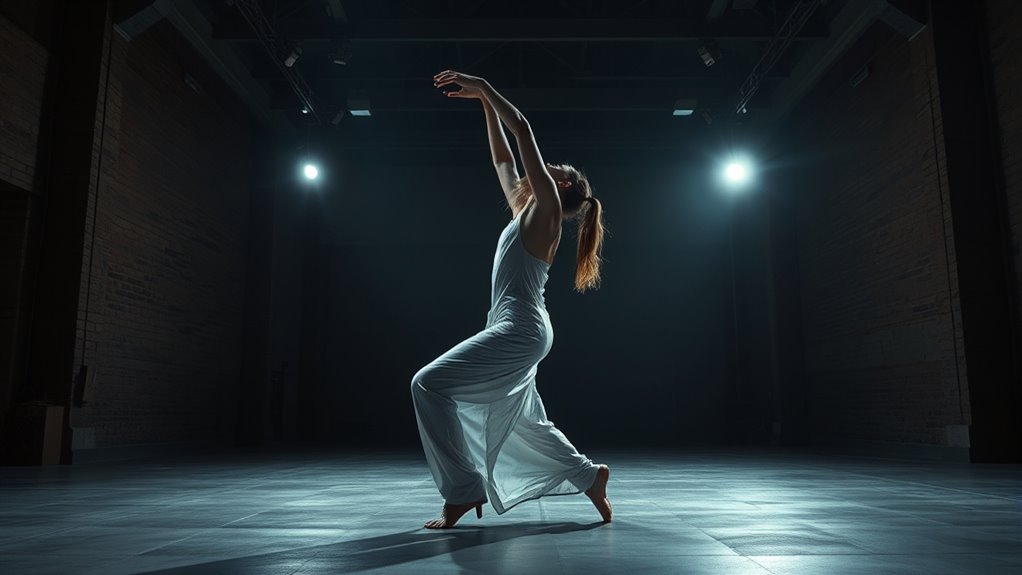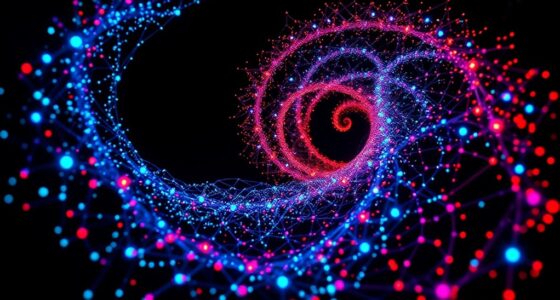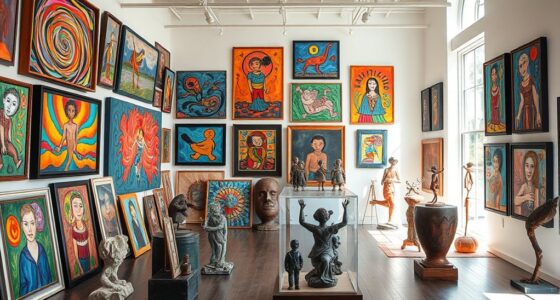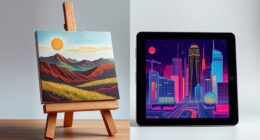Performance art pushes the boundaries of body and space by challenging traditional art forms with live, provocative, and often physical acts that involve audience interaction and innovative use of environment and technology. It emphasizes immediacy, exploring themes like identity, social norms, and political issues through movement, gesture, and endurance. By breaking conventions and integrating interdisciplinary methods, performers transform spaces and perceptions. If you’re curious about how artists continue to evolve these boundaries, there’s much more to discover.
Key Takeaways
- Performance art uses the artist’s body as a medium to challenge social norms and provoke visceral emotional responses.
- Artists incorporate physical endurance and risk-taking to explore physical and psychological boundaries.
- Site-specific and multimedia techniques expand spatial and contextual boundaries in performance practices.
- Audience participation and interaction disrupt traditional passive viewing, creating dynamic, ephemeral experiences.
- The integration of digital tools like VR and AI pushes the limits of body and space in contemporary performance art.
Origins and Influences of Performance Art
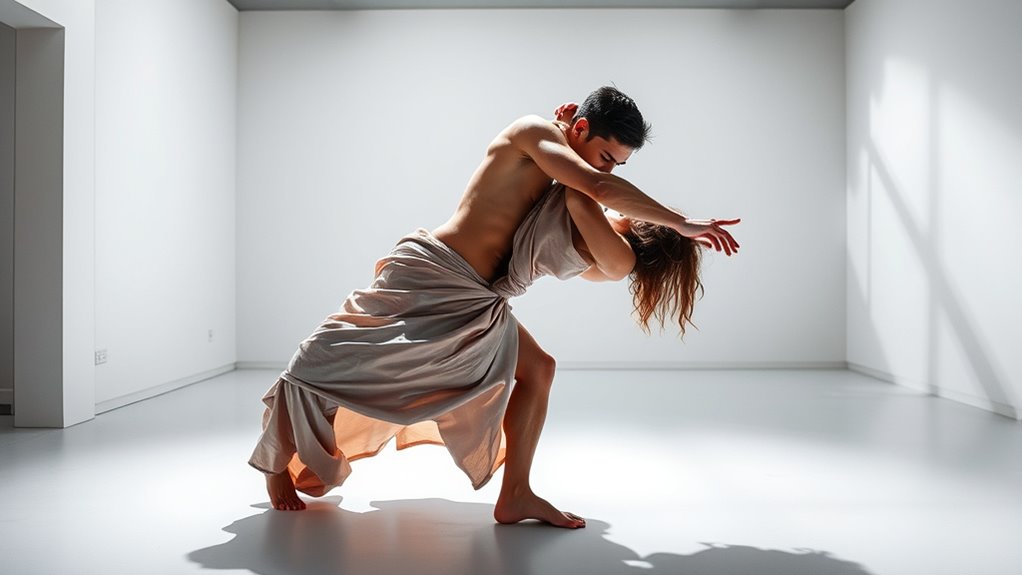
Performance art has its roots in the early 20th century, shaped by avant-garde movements like Futurism and Dada that challenged traditional artistic boundaries. You can trace its origins to the Cabaret Voltaire in Zurich, founded in 1916, where artists experimented with provocative, live events. Dada played a crucial role by rejecting conventional aesthetics through unconventional performances, inspiring artists to push limits. Futurism contributed energy and movement, emphasizing dynamism in expression. These movements fostered experimentation, encouraging artists to explore new forms of expression beyond traditional art. Influences from Surrealism added psychological depth, while the avant-garde spirit laid a foundation for performance’s evolving nature. This era’s experimental ethos continues to shape performance art’s boundary-pushing character today. The emphasis on spontaneity and live experience further distinguished it from traditional art forms.
Defining Characteristics and Techniques

The defining characteristics and techniques of performance art set it apart from traditional art forms by emphasizing live, immediate, and often provocative experiences. You’ll notice the live presence of artists or performers is central, with the body serving as the primary medium and conceptual material. Interaction is key, encouraging engagement between performers and audiences, making each piece unique and fleeting. Performance art is inherently transient, existing only during the moment of the event. Techniques include gestural performances that convey meaning through physical actions, improvisation for spontaneity, and documentation for preservation. Many works are site-specific or involve multimedia elements. These features push boundaries, challenge norms, and often deliver personal or political messages designed to elicit strong reactions and foster active participation. Performance art often employs experimental approaches, further emphasizing its role in challenging conventional notions of art and audience engagement. Incorporating innovative methods can expand the expressive possibilities and deepen the impact of performance pieces. Additionally, understanding the resources and tools available can enhance the development and dissemination of performance art projects. Exploring digital platforms and online audiences can also amplify reach and engagement in contemporary performance art practices. Staying informed about technological advancements and digital tools allows artists to experiment with new formats and extend their work beyond physical spaces.
Historical Evolution and Key Movements

Performance art has roots in avant-garde movements like Dada and Futurism, which challenged traditional art forms and emphasized experimentation. In the 1960s, artists expanded these ideas, creating new ways to engage audiences and break boundaries. Understanding these historical influences helps you see how performance art continuously evolved into a diverse and dynamic form. These early movements laid the groundwork for the development of performance art as a distinct discipline that incorporates live actions, audience participation, and conceptual exploration. Additionally, the integration of cultural influences from different regions has further enriched the scope and diversity of performance art over time. Recognizing the role of innovative techniques from these foundational movements highlights how technical experimentation remains vital to contemporary performance art. A deeper awareness of artistic experimentation underscores how pushing the limits of materials and methods continues to shape the evolution of performance art. Moreover, the adoption of experimental approaches has facilitated the blending of performance art with other contemporary disciplines, expanding its reach and impact. This ongoing interdisciplinary integration demonstrates how performance art stays relevant in a rapidly changing artistic landscape.
Avant-Garde Influences
Avant-garde influences have shaped performance art by challenging traditional notions of art and emphasizing innovation, experimentation, and social critique. You’re drawn into chaotic Dadaist acts that mock societal norms through absurdity, like Hugo Ball’s wild performances. Futurism propels you to imagine speed, technology, and movement, with gestures that provoke and challenge. Action painting turns the canvas into a stage, where artists like Pollock perform live with energetic drips and splashes. Nouveau Réalisme merges daily life with art, using everyday objects and live actions to blur boundaries. These movements inspire you to see performance as a radical act—an ongoing dialogue with society, space, and media. Incorporating modern toilet themes into performance art can also serve as a provocative commentary on contemporary consumption and waste, prompting reflection on environmental and societal impacts. The integration of artistic experimentation encourages pushing the limits of conventional performance, further expanding the boundaries of body and space. Additionally, understanding the cultural heritage of diverse communities inspires artists to incorporate traditional practices and narratives into their work, enriching the dialogue between past and present. Exploring historical evolution reveals how these influences have continuously adapted to societal changes, fostering innovative expressions.
1960s Performance Movements
Have you ever wondered how performance art evolved from experimental beginnings into a powerful social tool? In the 1950s and 60s, groups like the Zero Group in Düsseldorf pushed boundaries with light, space, and movement, emphasizing viewer participation over individual expression. They fostered international collaborations with movements like Gutai and Nouveau Réalisme, blending installation and performance to dissolve boundaries between artist and audience. During the 1960s and 70s, performance art gained recognition amid social upheavals like civil rights and feminism. Artists like Allan Kaprow created “Happenings,” emphasizing improvisation and audience involvement, while Fluxus artists merged art and activism through experimental acts. Key figures like Carolee Schneemann and Chris Burden used their bodies provocatively, challenging norms and exploring themes of gender, risk, and endurance. This period also saw the rise of performance art as a distinct discipline, emphasizing the importance of the body as a medium and the live event as a form of artistic expression.
Central Themes and Artistic Motivations

You’ll see how artists use their bodies as powerful tools to express complex ideas and challenge societal expectations. Performance art often pushes boundaries by confronting social norms through physical presence and action. This approach invites you to question what’s considered acceptable and explore new ways of understanding identity and culture. Additionally, many performers incorporate physical techniques to enhance their messages and deepen audience engagement. The integration of AI-driven storytelling further expands the possibilities for innovative and immersive performances. Techniques such as body modification are also employed to challenge perceptions of the human form and push artistic limits. Engaging with spiritual practices like meditation can heighten performers’ awareness and emotional depth, enriching their artistic expression.
Body as Medium
The body serves as a powerful medium in performance art, allowing you to communicate complex themes and evoke visceral emotional responses. You’re not just observing the performance; you’re experiencing the artist’s physicality, vulnerability, and discipline firsthand. Through gestures, movements, and endurance, artists use their bodies to symbolize social, cultural, and political issues. They push their physical and emotional limits, exploring pain, identity, and transformation. This approach creates a direct connection, bypassing language to reach your senses and emotions. Imagine witnessing:
- A performer holding a pose for hours, confronting their limits
- Movements that mimic societal struggles or personal stories
- Acts of vulnerability that challenge your perceptions
- Risky, transformative gestures that redefine what art can be
Understanding body as medium enhances appreciation for how physicality conveys profound messages beyond words. Incorporating self-watering plant pots into performance can symbolize nurturing or sustainability themes, exemplifying innovative ways artists integrate everyday objects to deepen their messages.
Challenging Social Norms
Body as a medium in performance art often pushes boundaries by confronting societal norms directly. You’ll see artists challenge traditional roles, using their bodies to question gender expectations, objectification, and power structures. Since the 1960s, performance art has emerged alongside social movements that demand change, prompting audiences to reflect on their beliefs. Feminist artists like Carolee Schneemann used provocative acts to confront gender norms head-on. Many works involve audience interaction, forcing viewers to confront uncomfortable truths and reconsider societal assumptions. By redefining space and encouraging participation, performance art blurs private and public boundaries. Its provocative nature sparks debate, challenges censorship, and inspires social transformation. Ultimately, you experience performance art as a catalyst for questioning, dialoguing, and pushing the limits of what society deems acceptable.
Pioneers and Notable Creators
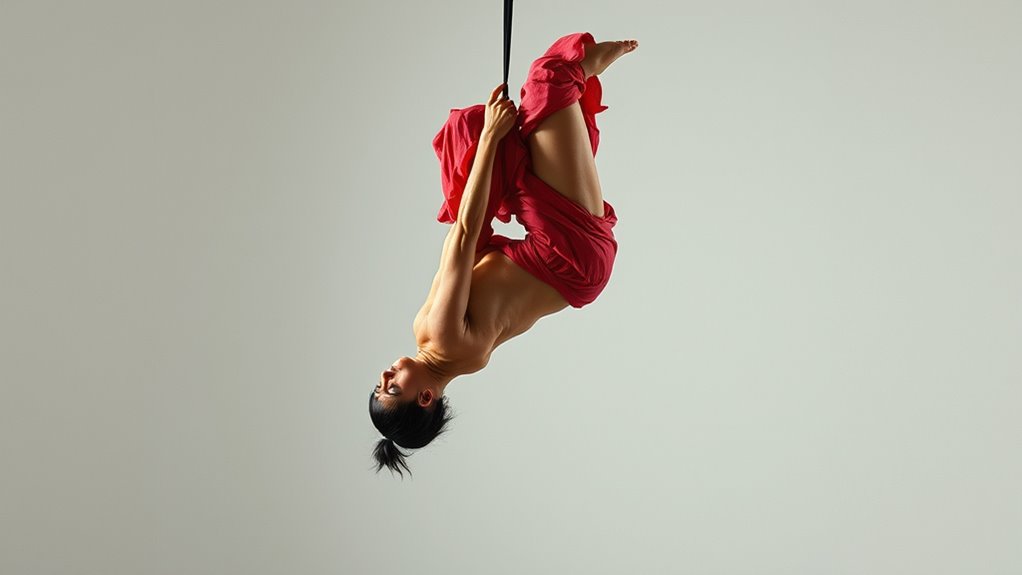
Pioneers and notable creators have shaped performance art through daring experimentation and boundary-pushing acts. You can see their influence in the way they challenge norms, use their bodies, and merge different art forms. Imagine Yoko Ono inviting you to cut her clothing in *Cut Piece*, or Yves Klein’s models transforming into living brushes during *Anthropometries*. Think of Jackson Pollock splattering paint in raw, energetic performances or Carolee Schneemann revealing her body to question gender roles. These artists push physical and psychological limits, inspiring future generations.
Performance art pioneers challenge norms, push boundaries, and merge art forms through daring, body-centered acts inspiring future creators.
- Dada artists like Hugo Ball and Emmy Hennings staging provocative, anti-rational acts at Cabaret Voltaire
- Chris Burden risking his safety in daring performances
- Joseph Beuys blending art with politics through symbolic actions
- Marina Abramović enduring extreme physical tests in *Rhythm 0*
Performance Art in the Contemporary World

Contemporary performance art pushes physical and spatial boundaries to challenge how you perceive and engage with live acts. You’ll notice artists integrating technology, like AI-generated visuals and soundscapes, blurring the lines between human bodies and digital domains. Themes such as identity, gender, and social justice are at the forefront, often explored through immersive, participatory experiences that invite your active involvement. Expect performances in unconventional environments—public parks, abandoned buildings, or natural sites—that dissolve traditional barriers and foster a sense of immersion. Collaborations with digital artists and technologists expand possibilities, incorporating VR and AR to push into virtual realms. Materials often reflect ecological concerns, emphasizing sustainability. Overall, performance art today is dynamic, interdisciplinary, and designed to provoke thought, foster dialogue, and redefine your relationship with body, space, and technology.
Frequently Asked Questions
How Do Performance Artists Ensure Safety During Extreme or Risky Acts?
You guarantee safety during extreme acts by conducting thorough risk assessments and developing clear safety protocols. You train extensively, collaborate with safety experts, and use appropriate protective gear. You obtain necessary permits for pyrotechnics, carefully review special effects, and supervise their setup. You inspect venues, keep aisles clear, monitor weather, and guarantee emergency exits are accessible. Maintaining first aid kits and crowd control measures further helps prevent accidents and guarantees everyone’s safety.
What Role Does Audience Participation Play in Performance Art?
Some might think audience participation could disrupt a performance, but it actually enhances it. You become an active part of the artwork, transforming the space and creating a shared experience. Your involvement blurs boundaries, making the performance more immersive and personal. This interaction fosters community, deepens emotional engagement, and often leads to unpredictable, dynamic events. By participating, you help shape the performance’s direction, making every encounter unique and meaningful.
How Is Performance Art Documented and Preserved for Future Reference?
You document performance art through various methods like video recordings, photographs, written notes, audio captures, and physical artifacts to preserve key moments. To guarantee their longevity, you use archival practices, conservation techniques, and digital repositories. Technological innovations like VR, 3D printing, and online platforms help share and maintain these works. Institutional support, including museums and grants, further sustains performance art documentation for future generations.
In What Ways Has Digital Technology Transformed Performance Art Practices?
Digital technology transforms performance art practices by expanding their reach and accessibility, allowing you to share work globally through live streaming and digital galleries. It enables you to create immersive experiences with VR and AR, fostering audience participation and cross-cultural exchange. You can also collaborate across distances and gather data on engagement, helping you refine your art. However, technical challenges and the loss of physical presence remain hurdles to overcome.
How Do Cultural Differences Influence Performance Art Styles Worldwide?
Did you know that over 60% of performance artists worldwide incorporate cultural elements into their work? You see, cultural differences shape performance art styles by blending regional traditions with modern themes. You’ll notice Asian influences exploring social issues, African artists highlighting local stories, and Latin American traditions inspiring contemporary pieces. These diverse styles challenge perceptions, foster cross-cultural exchange, and help you understand the rich, global tapestry of performance art.
Conclusion
As you explore performance art, you realize how it pushes boundaries and blurs lines between body and space. Its evolution reflects changing societal views, and each movement coincides with new ideas about identity, politics, and expression. You see how pioneers shape today’s practices, reminding you that art’s power lies in its ability to challenge and transform. In embracing these moments, you become part of a continuous, unexpected journey where art and life intertwine seamlessly.

